| Srl | Item |
| 1 |
ID:
134170
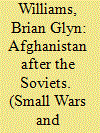

|
|
|
|
|
| Publication |
2014.
|
| Summary/Abstract |
In 1989 the Soviet Union withdrew its forces from Afghanistan leaving the embattled Afghan Communist government of President Mohammad Najibullah to fight against an emboldened mujahideen insurgency. Most experts expected a quick mujahideen victory once the Soviets were no longer directly involved in counterinsurgency operations in support of the Afghan government. But in the spring of 1989 the Afghan Communists beat the odds and defeated a mujahideen rebel offensive designed to capture the eastern city of Jalalabad. This proved to be a turning point, and for the next three years the Najibullah regime held out against the mujahideen 'freedom fighters'. In fact the Afghan Communist regime actually outlasted its sponsor the Soviet Union. The reasons for this remarkable achievement can be traced, in part, to ethnic-tribal divisions among the quarreling mujahideen parties and the Afghan government's ability to exploit them. This largely untold story has obvious implications for understanding the future of post-Karzai Afghanistan, tribalism, ethnicity, and foreign sponsorship in post-US Afghanistan. This article will explore the reasons for the resilience of the Najibullah Communist government and then assess possible implications for a post-2014 Afghan government.
|
|
|
|
|
|
|
|
|
|
|
|
|
|
|
|
| 2 |
ID:
065214


|
|
|
| 3 |
ID:
132298
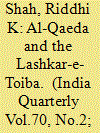

|
|
|
|
|
| Publication |
2014.
|
| Summary/Abstract |
Study of ideology is one of the most important domains of consideration for a successful counter-terrorism strategy. It is necessary to know and understand the ideology of a terrorist outfit coupled with the ongoing evolution at the same, its chief ideologues and its target audiences in order to provide an alternative ideology or in other words to win the 'hearts and the minds' of the people. This article traces the mounting similitude in the discourse and the actions of Lashkar-e-Taiba and the ideology of Al-Qaeda. The article begins with a brief depiction of the debate on the 'end of ideology' before proceeding on to an examination of Al-Qaeda's ideology. In the next section, LeT's discourse and actions from 1990 to 2010 are scrutinised followed by an analysis that attempts to draw out parallels between the ideologies of the two terrorist organisations. In the last section, the conclusion raises several pertinent points for the consideration of counter-terrorist specialists and policy makers.
|
|
|
|
|
|
|
|
|
|
|
|
|
|
|
|
| 4 |
ID:
130544
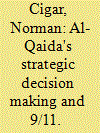

|
|
|
|
|
| Publication |
2014.
|
| Summary/Abstract |
As the united states draws down its military presence in Afghanistan, it is appropriate to revisit how the war was ignited and , in particular, Al-Qaida's role in that process. An understanding of Al-Qaida's thinking in preparing and executing this operations provides helpful insight into its decision making system and into its planning process in relation to both overall policy and, specifically, to its decision to launch the 9/11 operation in 2001.
|
|
|
|
|
|
|
|
|
|
|
|
|
|
|
|
| 5 |
ID:
144867
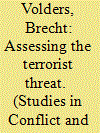

|
|
|
|
|
| Summary/Abstract |
Each terrorist organization faces a critical tradeoff between effectively managing the organization's violent behavior while remaining secure from counterterrorism efforts. Drawing on organization theory and terrorism literature, this article develops theoretical linkages between the organizational design of a terrorist group and this critical tradeoff. It considers the impact of four key design parameters: membership, operational space and time, formalization, and centralization. The first two structural parameters construct the physical anatomy of a terrorist organization. The latter two structuring parameters prescribe or restrict the behavior within this organizational context. Net advantages by means of rising structural design parameter values are increasingly offset by the organizational strength and security vulnerabilities that inherently follow from the rising structuring parameters.
|
|
|
|
|
|
|
|
|
|
|
|
|
|
|
|
| 6 |
ID:
125356
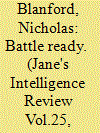

|
|
|
|
|
| Publication |
2013.
|
| Summary/Abstract |
As Hizbullah's fighting forces undergoes expansion, the number of its training facilities for urban operations is also increasing. Nicholas Blanford examines the group's use of these centres and the effect they are likely to have on its tactical capabilities.
|
|
|
|
|
|
|
|
|
|
|
|
|
|
|
|
| 7 |
ID:
057509
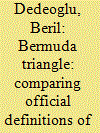

|
|
|
| 8 |
ID:
133678
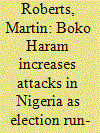

|
|
|
|
|
| Publication |
2014.
|
| Summary/Abstract |
As Nigeria approaches the final six months before a general election in February 2015, there are clear indication that's that the militant Islamist group Boko-Haram is implementing a multi-faceted strategy aimed at increasing the rate of attacks throughout the country.
|
|
|
|
|
|
|
|
|
|
|
|
|
|
|
|
| 9 |
ID:
134004
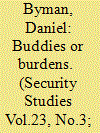

|
|
|
|
|
| Publication |
2014.
|
| Summary/Abstract |
Drawing on organization theory, this article argues that al Qaeda seeks affiliates to expand the scope and scale of its operations, gain the benefits of greater local expertise, better spread innovations, and?most important?endow itself and its mission with greater legitimacy. The conventional wisdom on al Qaeda affiliates emphasizes these benefits and thus paints affiliation as a tremendous boon to al Qaeda that magnifies the danger of terrorism. However, al Qaeda faces a host of problems related to delegation and integration, and often affiliation is a net loss. Divergent preferences and priorities, branding problems, shirking at the local level, adverse selection, and costly control mechanisms all make affiliates of questionable value to the core organization. Although the danger al Qaeda poses may have morphed with the core declining and the affiliates rising in importance, the broader movement is probably less dangerous than it was when the al Qaeda core was at its height. US counterterrorism often magnifies these integration problems and, if done well, can further induce friction, discredit the brand, and otherwise throw sand in the gears. The broader study of al Qaeda and its affiliates also offers insight into the study of organizations in general.
|
|
|
|
|
|
|
|
|
|
|
|
|
|
|
|
| 10 |
ID:
133536
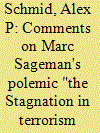

|
|
|
|
|
| Publication |
2014.
|
| Summary/Abstract |
Marc Sageman's lamenting about the "Stagnation in Terrorism Research" stands in stark contradiction to my conclusion in the Routledge Handbook of Terrorism Research (2011) that "Terrorism Studies-despite many shortcomings-has matured" and that "Terrorism Studies has never been in better shape than now." 1 While I agree with much else of what Marc Sageman says, there are a few points I disagree with. To begin with the notion of "stagnation": Terrorism Studies began, with few exceptions (Crozier, 1960; Thornton, 1964; Walter, 1964, 1969; Gaucher, 1965), 2 in the 1970s. Yet there had never been a period of real bloom in the 20th century-something which logically should precede the alleged stagnation after 9/11. As Andrew Silke noted in 2006:
|
|
|
|
|
|
|
|
|
|
|
|
|
|
|
|
| 11 |
ID:
133607


|
|
|
|
|
| Publication |
2014.
|
| Summary/Abstract |
Cyber terrorism is a phenomenon that is gaining more and more attention. One reason for this is the concern that modern information and communications technology may be used in order to harm open societies. This concern also involves actual IT systems and the information generated being targets of advanced attacks. That way functions that are important to society could be affected. The term 'cyber terrorism' is complex. This article describes the difference between traditional and cyber terrorism. The main focus is on how the al-Qaeda terrorist network acts in cyberspace and how their change in concentration and activities has made them a clever player in an electronic Jihad.
|
|
|
|
|
|
|
|
|
|
|
|
|
|
|
|
| 12 |
ID:
134090
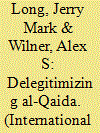

|
|
|
|
|
| Publication |
2014.
|
| Summary/Abstract |
Deterring terrorism is no longer a provocative idea, but missing from the contemporary theoretical investigation is a discussion of how delegitimization might be used to manipulate and shape militant behavior. Delegitimization suggests that states and substate actors can use the religious or ideological rationale that informs terrorist behavior to influence it. In the case of al-Qaida, the organization has carefully elaborated a robust metanarrative that has proved to be remarkably successful as a recruitment tool, in identity formation for adherents, as public apologia and hermeneutic, and as a weapon of war-the so-called media jihad. In the wake of the upheaval of the Arab Spring, al-Qaida and its adherents have redeployed the narrative, promising a new social order to replace the region's anciens régimes. Delegitimization would have the United States and its friends and allies use al-Qaida's own narrative against it by targeting and degrading the ideological motivation that guides support for and participation in terrorism.
|
|
|
|
|
|
|
|
|
|
|
|
|
|
|
|
| 13 |
ID:
082215
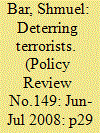

|
|
|
| 14 |
ID:
133684
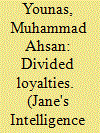

|
|
|
|
|
| Publication |
2014.
|
| Summary/Abstract |
The top leadership of the Jihadist militant organization Tehrik-e-Taliban Pakistan has fractured after months of infighting. Muhammad Ahsan Younas reviews the events that caused the group to fracture ant the implications for its future operations.
|
|
|
|
|
|
|
|
|
|
|
|
|
|
|
|
| 15 |
ID:
124841
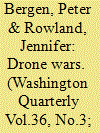

|
|
|
|
|
| Publication |
2013.
|
| Summary/Abstract |
At the National Defense University (NDU) on May 23, 2013, President Barack Obama gave a major speech about terrorismarguing that the time has come to redefine the kind of conflict that the United States has been engaged in since the 9/11 attacks. Obama asserted that ''[w]e must define the nature and scope of this struggle, or else it will define us.''1 Thus, the President focused part of his speech on the Authorization for the Use of Military Force (AUMF), which Congress had passed days after 9/11 and which gave President George W. Bush the authority to go to war in Afghanistan against al-Qaeda and its Taliban allies. Few in Congress who voted for this authorization understood that they were voting for what has become the United States' longest war, one that has expanded in recent years to countries such as Pakistan and Yemen
|
|
|
|
|
|
|
|
|
|
|
|
|
|
|
|
| 16 |
ID:
133508


|
|
|
|
|
| Publication |
2014.
|
| Summary/Abstract |
The study examines the effect of female suicide attacks on foreign media framing of conflicts. Examining the Palestinian-Israeli conflict, 2,731 articles were sampled that covered terrorist events (American, British, and Indian press); 625 appeared in the week following a female's suicide attack, 97 reported an attack by a female perpetrator. The findings suggest that foreign media discourse around female suicide bombers promotes more messages about the society within which the terrorists are embedded. Since the coverage of female terrorists tends to provide more detailed information about the perpetrator, it focuses more on the terror organizations' side of the conflict's story.
|
|
|
|
|
|
|
|
|
|
|
|
|
|
|
|
| 17 |
ID:
121922
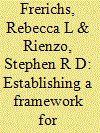

|
|
|
| 18 |
ID:
133507
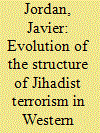

|
|
|
|
|
| Publication |
2014.
|
| Summary/Abstract |
This article studies the structure of jihadist terrorism in the West from the perspective of the existence or absence of links between grassroots militants and organizations such as Al Qaeda Central and its regional affiliates. It undertakes a comprehensive case study of jihadist militancy in a European country (Spain) over a period of almost two decades, from 1995 until December 2013. The study analyzes the results of 64 antiterrorist operations carried out during this time.
|
|
|
|
|
|
|
|
|
|
|
|
|
|
|
|
| 19 |
ID:
056511
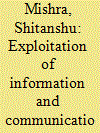

|
|
|
| 20 |
ID:
092920
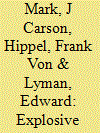

|
|
|
|
|
| Publication |
2009.
|
| Summary/Abstract |
The following discussion focuses on the question of whether a terrorist organization or a threshold state could make use of plutonium recovered from light-water-reactor fuel to construct a nuclear explosive device having a significantly damaging yield. Questions persist in some nonproliferation policy circles as to whether a bomb could be made from reactor-grade plutonium of high burn-up, and if so, whether the task would be too difficult for a threshold state or terrorist group to consider. Although the information relevant to these questions is in the public domain, and has been for a considerable time, it is assembled here for use by policy makers and members of the public who are concerned about preventing the spread of nuclear explosives.
|
|
|
|
|
|
|
|
|
|
|
|
|
|
|
|